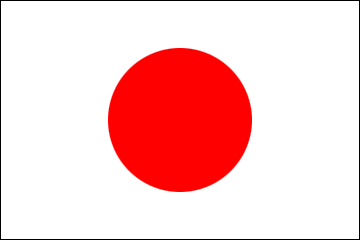Transctipt: tripartite talk on Japanese cuisine
2021/7/7
Tripartite talk between
Mr. Cyril Molard, chef of a two-star French restaurant “Ma Langue Sourit”,
Mr. Hajime Miyamae, owner of a Japanese restaurant “Kamakura” and
Ms. Kyoko Nishikawa, official chef of the Embassy
12, May 2021
at the official residence of the Ambassador of Japan
Mr. Cyril Molard, chef of a two-star French restaurant “Ma Langue Sourit”,
Mr. Hajime Miyamae, owner of a Japanese restaurant “Kamakura” and
Ms. Kyoko Nishikawa, official chef of the Embassy
12, May 2021
at the official residence of the Ambassador of Japan
Ms. Nishikawa : Let's start with two short questions: Chef Cyril cooperated with JETRO (Japan External Trade Organization) to promote "Wagyu" (Japanese beef). What do you think of Wagyu as an ingredient, and what do you think of Japanese cuisine?
Mr. Molard : I discovered Wagyu through JETRO. And when I discovered Wagyu, I really found that it is a very interesting product in terms of taste and texture, but that all the pieces are very, very tasty. In European beef, you don't always get all the tasty bits. In Wagyu beef, everything is excellent. And for me, it was really impressive. It's especially interesting to work with beef cuts that are a little cheaper than the very high quality Wagyu cuts, and to cook very beautifully. Cooking is not just about prices, with expensive products, it's also about knowing how to work with less expensive products. That's what it's all about!As for Japanese cuisine, I would like to go to Japan, since all cooks like me, the European enthusiasts, have all been influenced by Japan. By the acidity, the digestion, the salt, the way the plates are laid out, very clean, very clear, very focused. The Japanese have influenced us a lot in modern European cuisine, enormously. And they still influence us a lot. They are really people who have brought a lot of things to our plates.
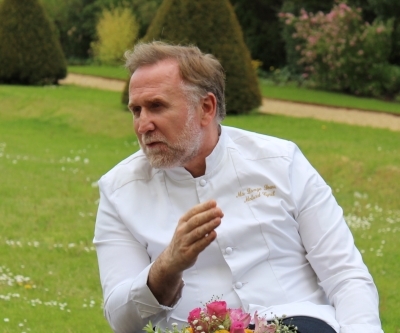
I think that lightness is the most important aspect nowadays. That people want to eat well, that it is light and easily digestible. Beautiful and light products, well-cooked and perfectly well-seasoned, that's very important. That's why classical French cuisine is going away, this rich cuisine with butter and cream, it's a bit too middle-of-the-road. It's a shame, but people need a bit more lightness.
Ms. Nishikawa : Wagyu beef has a lot of fat in it, so when I serve it in Japanese cuisine, I often combine it with wasabi, lemon, grated radish, etc. to make it lighter.
In French cuisine, the meat is often combined with a butter and foie gras sauce to make it richer. How did you find it?
Mr. Molard : Yes, that used to be the French cuisine. Now, Wagyu beef can also be combined with red wine. You always have to find a balance. That's why Japan intellectually brought a vision of lightness in terms of the condition of the work, of the cuisine, but I also thought of Northern Europe, like the Nordic countries, in terms of pickles and lacto-fermentation. The only thing we can keep from French cuisine, which is really important for us, is the sauce. We may make less rich side dishes, but we keep the "French sauce": the beef juice, the veal juice, the lamb juice. And nowadays, in the gastronomic plates of French restaurants, there is often less sauce on the plates, but it is much more concentrated. But you MUST have sauce. It is very important for us.
In fact, the sauce is the link between the meat and the wine. So, I think you can drink red wine with Wagyu. (laughs) The sauce is really important for us! It's really THE link. A beautiful meat, you need a beautiful sauce and a beautiful garnish. But the sauce is the most important thing. There are restaurants that don't use sauces anymore, but we still have a lot of sauces, still very French in technique. Sauces are very, very important.
In fact, I think that the sauce and the meat are like a “baba au rhum” and whipped cream. When you eat a baba au rhum, you want to eat the whipped cream. When you eat meat, you want to put a little of it in the sauce, to eat the meat. The sauce is like the dessert of the meat. It's the meat's delicacy. And when you put the bread in the sauce, it's like in Japan, there are traditions, we in France, we put the bread in the sauce, it's really the little pleasure of food appreciation.
Ms. Nishikawa : The "Kamakura" offers Wagyu. What kind of sauce do you use? Mr. Miyamae : For me, as a merchant, we must not waste any ingredients. We must always buy fresh products. We tried Wagyu, with the sauce, of course, and the lemon as well, as Mrs. Nishikawa said. But in the end, it's a meat with an extraordinary taste compared to other meats. Salt, pepper, bam, bam. It’s the best! Also with soy sauce or wasabi... for me, it's the best thing.
You know that in Japanese cuisine, we have four tastes: above all, we talk about "umami". It's the unique taste. They use, for example, tomato or dry fish to have umami. But the Europeans especially use, like the traditional French cuisine, the fat of the meat, which creates the taste similar to the "umami" that the Japanese use. And for our Japanese cuisine, we always eat rice, white and plain. So, not too much sauce: the natural product.
Mr. Molard : A little bit of sauce!
Mr. Miyamae : A little bit! But not much!
Mr. Molard : The difference between Mr. Miyamae and me is that I want the sauce! But not too much sauce, just a tiny bit of sauce! But, you know, you take your nice Wagyu, you sear it like you said, bam, bam, salt and pepper, and then you add a nice well-made beef sauce, just a little bit!
Mr. Miyamae: Of course. But sukiyaki and shabu-shabu are something else!
Mr. Molard & Ms. Nishikawa: (laughing)
Mr. Miyamae: The shabu-shabu is very simple: you have the umami of the kombu, since the broth itself is very basic, and then you add two different sauces, the soy sauce with ponzu, and the sesame sauce with a little bit of sweetness, whatever you prefer.
Mr. Molard : The shabu-shabu, we served it when I made people taste the Wagyu, I made a mushroom broth with vanilla. It's very French technique, very Nordic too. The people who tried it never ate Wagyu with vanilla before, it was actually: wow!
Mr. Miyamae: It's always a discovery, the cuisine! Mr. Molard is in it, he's a technician, I'm not a technician. I have to keep my identity.
Mr. Molard : He's right, both about the product and tradition.
Mr. Miyamae: Japanese cuisine is all about bringing out the best taste of the basic ingredient with technique, so no sauce. French cuisine is the opposite of that. They use the sauce for the best combination.
Mr. Molard : To bind things together, yes. But not too much sauce! Back in the day in France, 20 years ago, we used to put sauce all over the plate. Now, we put a little bit of the sauce, and that's enough! It's just like a condiment, you eat the sauce, maybe a pickle, and the meat is the main element. Japan has really taught us to cut down and to focus more. It's a difference, we are more focused on the taste. It's thanks to Japan, we learned a to limit things. But still keep the identity, you know?
Ms. Nishikawa: Mr Miyamae, has been running the Japanese restaurant "Kamakura" here in Luxembourg for over 30 years (since 1986). What do you think of the spread of Japanese cuisine in Luxembourg so far?
Mr. Miyamae: At that time, Japanese cuisine was not yet as fashionable as it is now. Japanese food was considered "a kind of Asian food". In France, there was already a second fashionable wave, first it was Sukiyaki, then Teppanyaki, which was created in the United States, and Yakitori. At the end of the 1980s, it was the birth of restaurants with raw fish, aimed at French customers. So what about Japanese cuisine in Luxembourg?
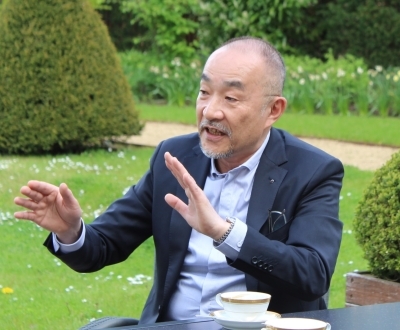
Back then, 50% of the customers used cutlery. Now there are days when nobody asks for them.
There are many Luxembourgers or other foreign customers, who are so much better regarding “eating with chopsticks”, than the Japanese. Because I have introduced them! (laughs)
Mr. Molard : He is the ambassador of Japanese cuisine! (laughs)
Mr. Miyamae: But no, but no. (laughs) It was changing, there was the wave of Japanese cuisine, which helped us a lot to make people understand. Thirty-two years ago now, people were criticizing us: "it's too expensive and it’s not enough". I was criticised a lot back then. So we tried to do it step by step. The raw fish represented only 3% of the turnover. And this 3% was consumed by Japanese customers. Nowadays, more than 50% of food eaten is based on raw fish. Not only sushi, but also other dishes. That is to say, most of our expenses for the purchase of basic ingredients is raw fish. I see this as a revolution in Japanese cuisine in Luxembourg. Now people understand that a small box of sushi can be 15 Euro per box. And we have an assortment of ten sushi for 28 Euro. That helped me a lot, this second wave, to give a perspective.
Mr. Molard : There is another thing that is very important for Kamakura and for us. There are two important restaurant guides in Europe: the Michelin Guide and the Gault&Millau Guide. And the day when the "Chef of the Year" was the Kamakura chef in the G&M, it was very important for us. Because they focused on a Japanese restaurant. The best restaurant of the year in Europe: a Japanese restaurant. And to everybody, that was simply "wow”!
Mr. Miyamae : It was the recognition of our cuisine. That is to say, Japanese cuisine became a part of the (European) cuisine, not French, Italian, Chinese - it was able to enter as itself.
Mr. Molard : Now you have: French, Italian, Spanish, Nordic, it's the same level. French is no longer "above" everything. Japan is at the same level as the “great” chefs, thanks to a lot of hard work. To do this in just 30 years, it's a lot, isn't it?
Mr. Miyamae : It was the recognition of our cuisine. That is to say, Japanese cuisine became a part of the cuisine: not French, Italian, Chinese, but it was also able to enter (in the Gault-Millau guide).
Mr. Molard : Now you have French, Japanese, Italian, Spanish, Nordic cuisine; it's all on the same level. For you, French cuisine is no longer on top, but everything is the same and at a very high level. That's why Japan is now on the same level as the very great cuisines, there's no problem there. It is even superior. This is also thanks to the work. But you have to do this over thirty years; it's a lot.
Mr. Miyamae : It's also a bit the fault of the Japanese and our mentality: we are specialists in importing things and we are specialists in improving things (laughs). So we copy and improve it and it has become part of the Japanese culture. But exporting our know-how, our culture - because if I may say so, the cuisine is a part of the Japanese cuisine - it took a long time. I still remember, on the first day, a lady booked a month before the opening and she let me prepare the dish I wanted. I made Kabuto and it takes almost 45 minutes to prepare. I served the dish, and the lady said, "No, I don't eat raw fish" and left. I served a live Tezukuri lobster for a Japanese customer. The man comes to the counter and says: "I am the vice-president of the animal protection association, and you must not do that (to animals)". So I asked him, "Sir, do you eat oysters?" He said, "Of course". I said, "Oysters, do you eat them dead?" He said, "I do not know" I said, "They are still alive and that is why they are so delicious." He said, "Oh, well! I did not know." You see, you often have to make the customer understand and it's not always easy.
Mr. Molard : And it takes time. Now Japanese cuisine is really on the same level as all other cuisines. There's no difference, it's very high level.
Mr. Miyamae : Imagine that every time you serve a Sashimi, you have to run to warn the customer that you don't put Wasabi on it. But now everyone knows that. It's also because of Japanese Manga, for example. Because of Manga, young people bring their parents and grandparents to the restaurant and that has helped us a lot too. For many people, Japanese cuisine is Sushi; but for example, in Kaiseki, you cannot find Sushi. Mrs. Nishikawa, you do not serve Sushi in Kaiseki, the cuisine you learned. You have to show people, that Japanese cuisine is not only Sushi.
Mr. Molard : It has not only Sushi, there are many, many other things.
Mr. Miyamae : Before, there was no image of Japan and people knew nothing about it. Now people are starting to know our culture. They are also starting to copy it, but they are not good like the Japanese (laughs). If you see kids eating Ramen or rice like this [eat quickly], they try to do the same thing in my restaurant. So, you have to show them and dare to intervene, and that way, the first time they travel to Japan for the first time, they will know! So that's the big problems of Japanese cuisine here and now.
Mr. Molard : This is also a problem of globalisation. Often the people who make sushi are not Japanese.
M. Miyamae : For that is not a problem. If you go to a three-star French restaurant in Tokyo, not everyone is French either. But they try to learn and they want to understand the cuisine.
Mr. Molard : I agree, you have to try to understand the cuisine. Because understanding how we eat is also understanding the culture.
Ms. Nishikawa : What do you think of the appeal of Japanese cuisine after having served it to many people as a chef at the official residence?
Mr. Molard : The charm of Japanese cuisine is tradition.
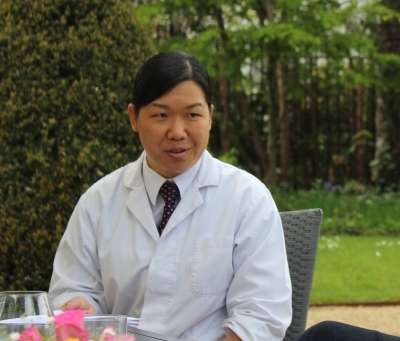 Ms. Nishikawa : I have been in Luxembourg for seven years, and when I arrived I was determined to serve my speciality, traditional Kaiseki cuisine, to the guests. However, as I ate in restaurants and interacted with guests, I naturally gravitated towards dishes with a Luxembourgish flavour. Luxembourg is home to foreigners from 170 different countries, and although it is landlocked, there is a great diversity of ingredients and food cultures. In this situation, the appeal of Japanese cuisine lies not only in meat and fish dishes, but also in vegetarian dishes, which are mainly vegetables.
Ms. Nishikawa : I have been in Luxembourg for seven years, and when I arrived I was determined to serve my speciality, traditional Kaiseki cuisine, to the guests. However, as I ate in restaurants and interacted with guests, I naturally gravitated towards dishes with a Luxembourgish flavour. Luxembourg is home to foreigners from 170 different countries, and although it is landlocked, there is a great diversity of ingredients and food cultures. In this situation, the appeal of Japanese cuisine lies not only in meat and fish dishes, but also in vegetarian dishes, which are mainly vegetables.
Mr. Molard : In Luxembourg, too, more and more people prefer vegetable dishes, and the cuisine has to be adapted to this. In Japan these dishes have been around for a long time. Vegetable dishes are not a problem for you. In France too, we have re-targeted ourselves towards this. We don't only want to make vegetarian dishes, but we want to be flexible to make small tastings with only vegetables and we have to have the capacity to make dishes with only vegetables. But we also want to make proteins. For my culture, it's important to have proteins, but we are now able to make menus with vegetables. All restaurateurs now have to be able to have the flexibility to do only vegetables or meat and fish; but the vegetables have to be as good as the meat and fish. Before vegetarian cuisine in France was a mixed salad and potatoes. Now restaurants are forced to think about how to improve the vegetarian plate. In any case, vegetables are very important for us, but I would also like to continue to prepare proteins, such as fish, etc., which is important for me. The vegetable plate should be as beautiful as the rest.
Mr. Miyamae : This is why in Japanese cuisine there is rice and also tofu to provide us with proteins.
Ms. Nishikawa : In Japanese cuisine, there are fermented dishes, such as Miso and pickles. Is this the case in French cuisine?
Mr. Molard : Of course, we have mustard, cheese etc. However, many French cooks use Miso in their dishes. Miso has become a utensil, but we don't use it as well as you do (laughs). Miso and fermented dishes have become important, as well as lacto-fermented vegetables. Most restaurants are now doing lacto-fermentation, for example for vegetables that are a bit spoiled, we put them in jars to ferment. This week, for example, we also made lacto-fermented mustard seeds for the next menu. We work a lot on this, but not as much as the Japanese. It has become a part of the cuisine too: lacto-fermentation, acidity, condiments, etc.
Mr. Miyamae : You are fifteen centuries late (laughs).
Mr. Molard : We have made acid mustard seeds, like condiments, which we will serve with fish. We see that the fish with these seeds is sufficient and essential. We also learned this from Japan, to make things more "clean". These mustard seeds with the fish are really fantastic. We still add a little sauce, we can't do otherwise (laughs).
Ms. Nishikawa : What is the key to promoting and enhancing Japanese cuisine in Luxembourg in the future?
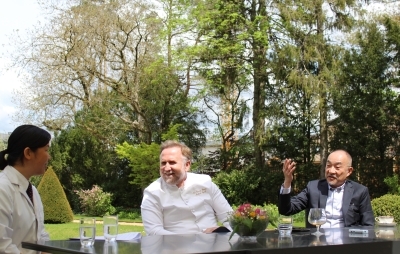 Mr. Molard : Firstly, by respecting it. That is to say, when we go to eat at Kamakura, or in very prestigious restaurants, we must respect tradition and also try to understand it. We know that we are behind in our cooking compared to you, for example in fermentation, but we have to accept that Japan is well ahead and in France we have a lot to learn. If in France we say to ourselves that we don't know everything, we respect Japanese cuisine, because we are learning. The fact of accepting to understand and to say "I do not know, but I want to learn" is already respect for Japanese cuisine. In France, for a long time, we thought that it was the best cuisine in the world, and that only French cuisine counted in the world, whereas there are many cuisines in the world that are great. Already when you have the humility to learn the cuisine of others, you respect Japanese cuisine. For me, a Japanese chef and a French chef are on the same level. It's real intellectual work.
Mr. Molard : Firstly, by respecting it. That is to say, when we go to eat at Kamakura, or in very prestigious restaurants, we must respect tradition and also try to understand it. We know that we are behind in our cooking compared to you, for example in fermentation, but we have to accept that Japan is well ahead and in France we have a lot to learn. If in France we say to ourselves that we don't know everything, we respect Japanese cuisine, because we are learning. The fact of accepting to understand and to say "I do not know, but I want to learn" is already respect for Japanese cuisine. In France, for a long time, we thought that it was the best cuisine in the world, and that only French cuisine counted in the world, whereas there are many cuisines in the world that are great. Already when you have the humility to learn the cuisine of others, you respect Japanese cuisine. For me, a Japanese chef and a French chef are on the same level. It's real intellectual work.Mr. Miyamae : For me, if we want Japanese cuisine to be properly exported, properly presented, we have to change ourselves. We are quite closed, and we are so proud of our culture. Now, Japanese food doesn't necessarily have to be prepared by a Japanese person. In Tokyo, if you look at the starred restaurants, they are Japanese chefs, not French ones. So we must open our doors, accept young chefs who want to learn Japanese cuisine and we must welcome them. And we have to welcome them well. In Kyoto, we have started since our cuisine was classified (as intangible cultural heritage) by UNESCO, but it is only one or two people per year. That's not enough. I often get reports from the Ministry of Culture to give them ideas on Japanese cooking events in Paris or London for example, with great success. For me, however, this is not Japanese cuisine. You pay ten euros for sake and sushi and many people go there. With that kind of budget, the Ministry could send a teacher to the (hotel) school in Diekirch, for example, to give Japanese cooking classes to learn the basics. Because of our low birth rate in Japan, very few people want to become cooks and especially traditional cooks. So, we should open our doors to foreigners who want to learn and who can carry our culture. Of course, they are not Japanese, but I would like to see a Luxembourgish person who has done internships in Kyoto and who has a Japanese restaurant. In France too, we should start doing this.
Mr. Molard : I bought a Yakitori and it's in my kitchen now.
Mr. Miyamae : That's it! I would like there to be more exchanges and for that, we must also open the doors to young people. For me, it's not the Japanese of my generation who carry (the envy for Japanese cuisine) but the younger generations.
Ms. Nishikawa : Some Japanese foods are expensive, such as sushi, tempura and wagyu beef, but there are also more common foods and B-grade gourmet foods. In Japan, the term "B-grade gourmet" refers to cheap, common and delicious food eaten on a daily basis, rather than A-grade cuisine prepared with expensive ingredients and first-class service.
Mr. Molard : I think that a French cook who can make a very nice fish dish with whiting is stronger than a French cook who makes a very nice fish with turbot. For me, there is more merit in making a good dish with a whiting than with a turbot, which is much more expensive. That's what cooking is all about: it's not just the expensive product. You can make a very nice dish with mackerel. You don't have to buy caviar and foie gras. That's what cooking is all about.
Ms. Nishikawa : Today, I'm going to introduce you to some of these B-grade gourmet dishes. I was inspired by dishes that Chef Molard served in his food truck.
Mr. Molard : I am very interested. I do not mind doing B-grade cooking. Doing good B-grade cooking is a real cook.
Mr. Miyamae : I find these A and B categories disturbing.
Mr. Molard : Yes, you are right.
Mr. Miyamae : For example, tempura today is more upmarket. But tempura was originally prepared on the street. Sushi, in the beginning, was for the workers.
Ms. Nishikawa : These dishes can be sold by food trucks, and they are popular as home cooking, enjoyed by both children and adults.
Mr. Molard : Gastronomy must now be for everyone. In a restaurant, you see people who have a lot of money, and there are people who save up to go to a restaurant, to celebrate a birthday, for the children, for the wedding anniversary. The restaurant is for everyone. You don't have to go too far in price. Gastronomy is not just for the very rich. Even with two or three stars, the restaurant can be accessible. Obviously, the price can be higher because of the staff etc., but you have to find the right balance. It must not be too ostentatious, too rich. For me, gastronomy is for everyone. In Japan, it must be the same, I think. Good food doesn't have to mean very expensive products, you have to think differently, especially now.
(The talk was followed by a cooking challenge of Takoyaki (octopus dumplings), Kushikatsu (deep-fried skewers) and Kara-age (deep-fried chicken).
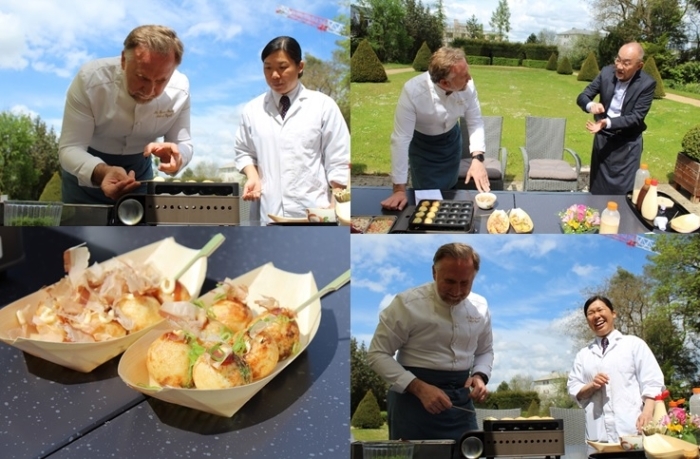
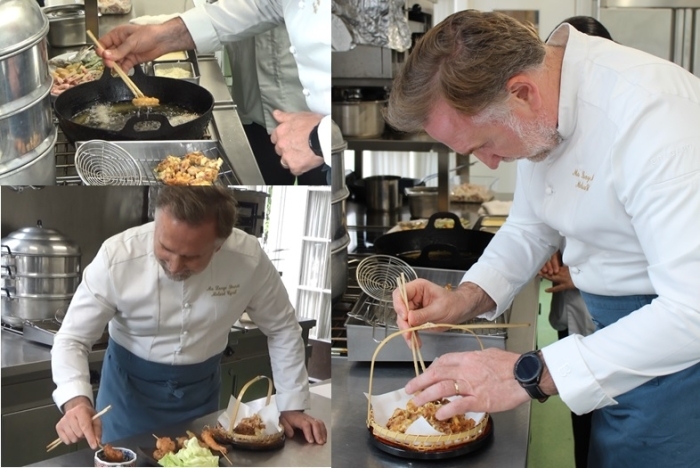
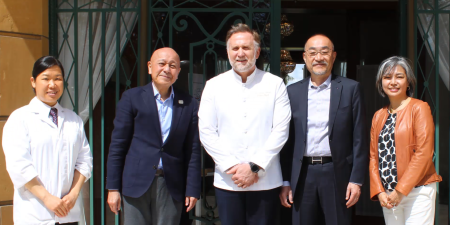
(Left to right: Ms. Nishikawa, Ambassador Okuyama, Mr. Molard, Mr. Miyamae and Mrs. Okuyama)
